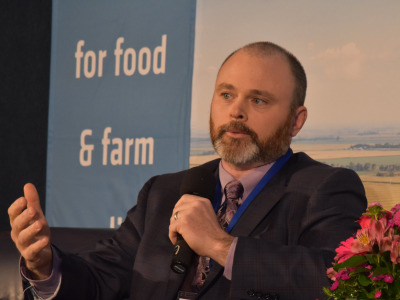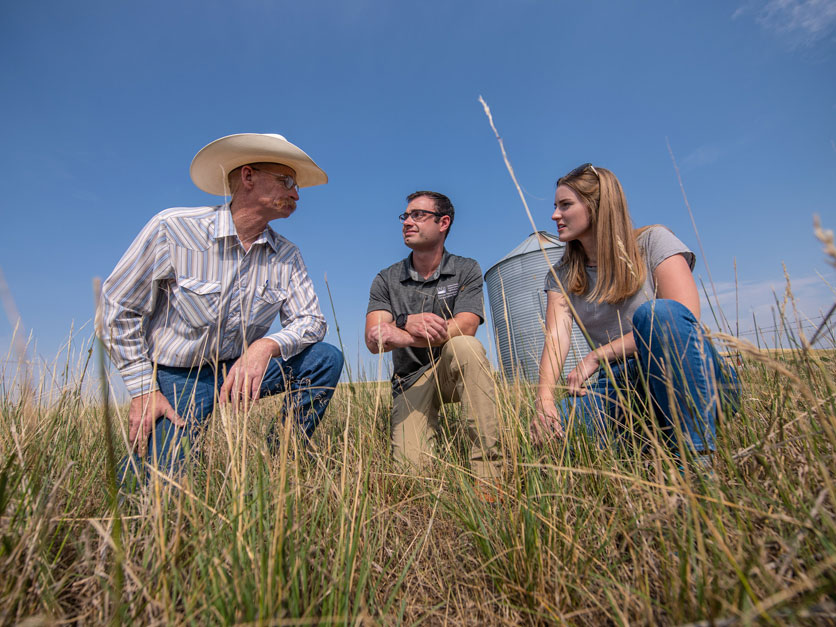It took three tries for Jacob Bolson to secure a spot in the Agriculture Department’s Conservation Stewardship Program.
The Iowa farmer filed his first application in 2021. Denied. He made another attempt in 2022. Denied.
He finally got a call last fall from his district conservationist, who encouraged him to try again after USDA's Natural Resources Conservation Service got a boost in conservation funding through the Inflation Reduction Act. After rushing to complete the paperwork, he was approved at last.
“It was pretty disheartening that even with beginning farmer status, we weren’t rejected once,” Bolson told Agri-Pulse. “We were rejected twice.”
The Hardin County farmer’s situation is not unique. While thousands of producers line up for government assistance through CSP and the Environmental Quality Incentives Program each year, less than one-third have historically been able to get in. And that trend continued in 2023, despite both programs collectively being infused with $500 million in additional authorized funding through the Inflation Reduction Act.
Only 34,222 of the 134,450 producers who applied to EQIP, about 25%, were awarded contracts in FY2023, according to a new report by the Institute for Agriculture and Trade Policy. Meanwhile, 11,038 of 35,683 CSP applicants, or 31%, were awarded contracts that year.
The report indicates the additional IRA conservation funding is helping more producers get into the program. NRCS enrolled 2,366 more people in EQIP in FY2023 than it did the year prior, while CSP saw an additional 3,078 awardees.
 Michael Happ, IATPBut despite the overall increase in awardees, the percentage of applicants able to secure spots in either program remains similar to prior years, the report says.
Michael Happ, IATPBut despite the overall increase in awardees, the percentage of applicants able to secure spots in either program remains similar to prior years, the report says.“They’re doing the right thing, they’re using this money for good things,” Michael Happ, a program associate for IATP, said of NRCS’s rollout of the IRA dollars. “It’s still just barely scratching the surface of the oversubscription crisis.”
Congress first established EQIP in the 1996 farm bill, merging other conservation programs that existed at the time. The program provides cost-share and incentive payments to producers who sign contracts as long as 10 years promising to implement new environmental practices, like cover crops, no-till and prescribed grazing. The money can also fund new fencing and irrigation equipment.
The program operates with $2 billion in annual baseline budget authority given to it through previous farm bills, according to the Congressional Budget Office. This money needs to be allocated to all 50 states, while also following specific instructions laid out in the 2018 farm bill. Half of it needs to go toward livestock operations, at least 10% must be dedicated to wildlife habitat, and 10% toward source water protection. Another 10% is split evenly between socially disadvantaged farmers or ranchers and beginning farmers and ranchers.
The program was infused with a combined $7.9 billion in additional budget authority over 10 years through the Inflation Reduction Act, according to CBO’s May 2023 baseline projections. This funding is specifically targeted toward “climate-smart” practices, like feed management, cover cropping for moisture use efficiency, biochar production and prescribed burning.
CSP, which was created in the 2002 farm bill and then overhauled and renamed in 2008, is geared more toward producers who have already implemented some conservation practices in previous years and are looking to expand and use more.
The program typically requires a longer-term commitment than EQIP, with producers signing five-year contracts for not only maintaining conservation practices that have already been established but for adopting new ones as well. While EQIP usually pays for one practice after it has been completed, CSP provides annual payments throughout the contract's duration.
The program has been allocated less funding than EQIP, with $1 billion in budget authority annually, according to CBO. However, it was given a combined $3.07 billion in additional net budget authority over 10 years through the Inflation Reduction Act.
The NRCS had $250 million in additional net budget authority for each program last year due to the Inflation Reduction Act funding, with those amounts expected to increase annually through 2026. For instance, the agency will have $1.6 billion in net budget authority under the IRA for EQIP and $471 million for CSP in 2024, according to the CBO projections.
Agriculture Department spokesman Allan Rodriguez told Agri-Pulse in an email that “more farmers and more acres” are currently enrolled in voluntary conservation practices due to the IRA funding “than at any single point in history, following a backlog that has existed for years.”
“Even with this funding, USDA is seeing more demand than we have funds to support,” Rodriguez added.
The agency’s work to roll out the additional FY2023 funds amid increasing applications from farmers was an accomplishment for the agency, which has struggled with keeping its state and local offices staffed in recent years, said Jesse Womack, a policy specialist with the National Sustainable Agriculture Coalition.
“USDA had a short year,” Womack told Agri-Pulse. “IRA funds weren’t available until almost, I think, April. And they still obligated every dollar and met increased farmer demand and had an absolutely slam-dunk year spending these new resources.”
It’s easy to be “in the know” about what’s happening in Washington, D.C. Sign up for a FREE month of Agri-Pulse news! Simply click here.
Rodriguez said NRCS has obligated 99.8% of the overall $850 million allocated for FY23 for both programs along with the Agricultural Conservation Easement Program (ACEP) and Regional Conservation Partnership Program (RCPP).
He also said agency has “focused its efforts on ramping up recruitment and hiring, training, retaining employees and business planning to meet the additional hiring needs to implement the Inflation Reduction Act, including more than 4,000 NRCS staff and nearly 3,300 partner staff.”
He added that the additional IRA funding “frees up” the programs’ farm bill dollars to be used for other types of practices, like organic and urban agriculture, soil health, water quality and quantity and wildlife habitat development.
Jonathan Coppess, an associate professor of agricultural policy at the University of Illinois, told Agri-Pulse the increase in applications could be driven in part by current “pressure” on farmers to incorporate practices like cover crops or implement nutrient loss reduction strategies.
“There is just incredible demand from farmers for these programs and these dollars,” Coppess said. “So, the IRA, while it helps, also kind of demonstrates that there is far more demand for conservation out there than we, and by we I mean Congress, has yet put into these programs.”
Coppess also said the high application numbers will likely make their way into a larger debate currently brewing between Democratic and Republican agriculture committee leaders over whether to move the IRA’s funding for climate-related farming practices into the farm bill.
While doing so could permanently boost funding for conservation programs, it could also open the possibility of the conservation funding being diverted for other purposes. Republicans on the Senate Agriculture Committee would like to remove the IRA restrictions that limit the funding to climate-related practices. Republicans on the House Agriculture Committee would like to go a step further and move some of the IRA funding into other areas of the farm bill.
Senate Agriculture Committee Chairwoman Debbie Stabenow is open to moving the IRA money into the farm bill but has insisted on keeping the climate guardrails.
According to the IATP’s analysis, farmers from Rhode Island were most able to secure spots in EQIP and CSP. All 24 farmers in the state who applied for CSP were awarded contracts, while 65% of the 269 who applied for EQIP were accepted.
Puerto Rico, West Virginia and Ohio, meanwhile, granted CSP contracts to between 70% and 81% of the producers who applied. Mississippi and Minnesota had the lowest rates of acceptance for CSP, awarding contracts to only 8.01% and 12.13% of applicants, respectively.
 Jonathan Coppess, University of IllinoisAlaska, Massachusetts and Idaho followed Rhode Island in granting the highest proportion of EQIP applications, with the three states accepting between 52% and 61% of interested farmers. North Carolina, Mississippi, Oklahoma, Louisiana, and Arkansas all had the lowest rate of acceptance for EQIP, only allowing between 16% and 19% of interested producers into the program.
Jonathan Coppess, University of IllinoisAlaska, Massachusetts and Idaho followed Rhode Island in granting the highest proportion of EQIP applications, with the three states accepting between 52% and 61% of interested farmers. North Carolina, Mississippi, Oklahoma, Louisiana, and Arkansas all had the lowest rate of acceptance for EQIP, only allowing between 16% and 19% of interested producers into the program.Cover crops appear to be the most popular practice utilized under EQIP, followed by fencing and brush management, according to NRCS data IATP shared with Agri-Pulse.
Josh Nelson, who farms rye, oats, corn and soybeans near Belmond, Iowa, secured a five-year EQIP contract for implementing a multispecies cover crop and conservation crop rotation in 2021. He said it “basically covers” all his cover crop expenses, which include application and seed costs.
“It does allow me to have some flexibility in choosing species that I probably wouldn’t choose if I was just starting out cold,” Nelson told Agri-Pulse.
During the application process, Nelson did run into difficulties getting his contract scored. He said he had to go through “three or four different iterations” of the contract before it finally got approved. While he worked with NRCS staff to refine his application, he said the time-consuming process and a lack of available staff may dissuade other farmers from attempting to enroll.
“There’s got to be a lot more effort put into getting farmers to come around to these things and make sure that it’s not the four- or five-time application,” Nelson said. “Because you’re only going to get the hardcore nerds, people like me. You’re not going to get some of these guys that are already skeptical.”
For more news, go to Agri-Pulse.com.


